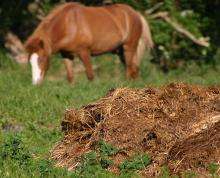Image: Wikipedia.
Giving new meaning to the term "server farm," a team of Hewlett-Packard researchers has come up with a plan for combining cow chips and computer chips to build an environmentally friendly data center -- powered by manure.
In a paper set for release this week, HP scientists have proposed using a "biogas" recovery system that would convert livestock waste into methane, to be used as fuel to generate electricity for data centers -- those cutting-edge computer facilities that serve as the nerve centers for an increasingly Internet-dependent world.
In turn, the system would use the heat produced by the banks of server computers -- sometimes referred to as server farms -- to assist the process of converting the animal waste into fuel.
The result is what Chandrakant Patel, a scientist at HP Labs in Palo Alto, Calif., calls "a symbiotic relationship between manure and IT."
Patel, who recalls collecting buffalo droppings for fuel as a boy in rural India, says the ancient practice of burning manure for energy can be updated with new technology, in a process his team has outlined in a paper they're presenting this week at a conference on energy sustainability, convened in Phoenix by the American Society of Mechanical Engineers.
HP says it has no immediate plans to build a dung-powered data center.
But these days, energy efficiency is an industry Holy Grail.
Modern data centers require vast amounts of electricity, both to power their high-tech components and to run air conditioners that keep the computers from over-heating. That translates to high energy bills and a big carbon footprint, at a time when corporations face growing pressure to be green.
Some big tech companies, including Google and Microsoft, have built large data centers in the Pacific Northwest, where power from hydroelectric dams is plentiful and less pricey.
But that's not always an option, and Patel said that ideally a data center should be able to tap multiple energy sources, depending on whether solar, wind or biogas power is available, while using non-renewable power as a back-up.
Patel, an engineer with more than 100 patents to his name, oversees an HP Labs group that works on reducing the environmental impact of the modern tech infrastructure. After coming up with several advances to reduce the energy demand of large computer systems, Patel said, they began looking at alternative sources of power for data centers.
He's not the only team member who has first-hand experience with livestock and manure. One of his co-authors, computer scientist Martin Arlitt, comes from a Canadian ranching family and, according to Patel, "shoveled a lot of the stuff" as a young man.
The average dairy cow produces 20 metric tons of manure per year, according to the researchers, who say they'd need 10,000 cows to power a 1-megawatt data center, which they describe as a small to medium-sized facility. They propose converting the waste into methane gas through a biological process called anaerobic digestion, which is more efficient and less smelly than simply burning the manure. The methane would then be used as fuel in gas-fired generators to create power.
The science behind their idea is well-established, said Steffen Mueller, principal economist for a U.S. Department of Energy program at the University of Illinois, which advises farmers on using biogas systems to produce their own electricity and heat.
Mueller said he's never seen a biogas-powered computer facility. But he added, "there are a lot of potential synergies. You just have to be willing to locate the data center where the fuel is. I don't think you want to ship the manure to Silicon Valley."
With today's high-speed networks, Patel says it's possible to build computer centers near farms in rural areas. He also sees big potential for using biogas power in developing nations, where electricity is expensive and the existing grid can't support much tech infrastructure.
"This could be an opportunity for emerging economies," he said, "where the need for IT services will be greater and greater."
(c) 2010, McClatchy-Tribune Information Services.



















